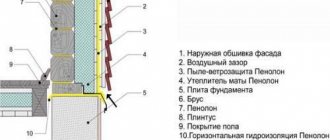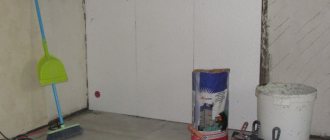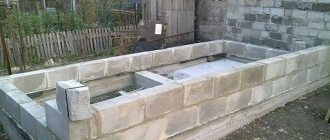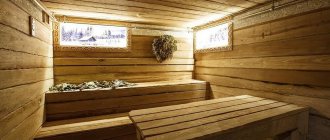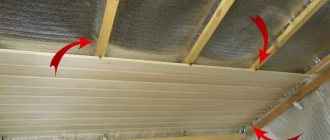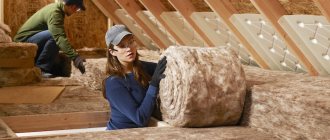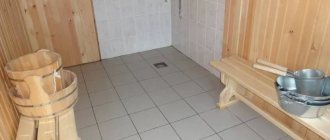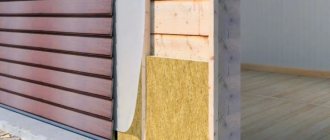Anyone who has decided to engage in frame construction understands that a lot depends on insulation.
And here a number of questions arise: what insulation to choose, how to insulate it, is it worth insulating the floor or ceiling additionally, or paying special attention to the walls?
If we are talking about the construction of a frame bath, then it is extremely important not to make a mistake, since this room is subject to the influence of high humidity and large temperature changes.
Therefore, when insulating a frame bath, you must approach the process with full responsibility.
A mistake can result in you getting constantly damp walls that are completely unable to retain heat. Insulation can be done with your own hands.
DIY bath frame
Mineral wool
The classic method of insulating the ceiling in a bathhouse is the use of mineral wool. There are three main types of mineral insulation: basalt, fiberglass and slag wool.
Basalt is produced in slabs of standard sizes or in rolls of standard width. Thicknesses typically used are 50 and 100 mm. Attention should be paid to the fact that the ceiling in the steam room is precisely the surface that is subject to extreme influences of temperature and humidity. The thickness of the insulation on the ceiling must be at least 150 mm. Experts recommend installing in three layers of 50 mm with overlapping joints. The density of the material is usually 35-40 kg/m3.
Important point! When using mineral insulation, it is laid directly on the rough ceiling, without using a vapor barrier between the heat insulator and the ceiling.
Basalt fiber has the following significant advantages:
- Excellent mechanical strength allows installation on surfaces of any configuration.
- High thermal insulation ability. The low coefficient of thermal conductivity contributes to maximum heat conservation in the room; the insulation also has high noise and sound insulation characteristics.
- Resistant to sudden temperature changes. Some manufacturers claim that their product can withstand up to 200 heating and cooling cycles.
- Immunity to the appearance of bacteria, fungi, mold. Basalt is not attractive to rodents and insects.
- The main advantage can be considered the fire safety of the material, which not only does not support combustion, but also, when heated, does not emit harmful fumes.
- Basalt-based slabs are easy to cut and install.
The disadvantages include:
- The relatively high cost of this type of mineral insulation, given the need to install a layer with a total thickness of 150 mm.
- When wet, mineral wool loses its beneficial properties, so it is important to use it only with vapor and waterproofing materials.
Fiberglass is also often used as insulation.
Material based on quartz fibers has the same technical characteristics as basalt material:
- Fiberglass, due to its fibrous structure, has a low thermal conductivity, which is 0.039-0.047 W/m K.
- The flammability group of many quartz-based products is NG, which means non-flammable. Some are marked with the G1 value, that is, they do not support combustion. At high temperatures, the fibers begin to sinter without releasing harmful substances.
- The moisture resistance of this material is slightly higher than that of basalt, however, the use of fiberglass in tandem with vapor and waterproofing is mandatory.
- Biological inertness does not allow fungus and mold to develop in the thickness of the insulation.
- The elasticity of the material allows it to withstand increased deformations, and after removing the load, return to the original geometric dimensions.
- Low cost.
Disadvantages of the material:
- Short service life.
- Installation should only be carried out in a protective suit and precautions must be taken, since small fiberglass fibers can irritate the skin and are very dangerous for the respiratory tract. In addition, it is recommended to install this heat insulator not from the steam room side, but from the attic side.
The main feature of the thermal insulation of a bathhouse is the use of a foil layer in the insulation “pie”. As a rule, to do this, foil is placed on the selected heat insulator, gluing the joints with aluminum tape. It is foil that is the material that provides the “thermos effect” in the steam room and reflects infrared heat from the stove into the room. It is especially important to pay attention to difficult-to-insulate components in the corners of the room, in the opening of a window or door. If you neglect the thoroughness of sizing, there is a high probability that there will be places through which steam will enter the insulation, which, in turn, will quickly become unusable.
Many mineral wool manufacturers offer the consumer specially designed products with a foil layer already applied. The benefits of such proposals are obvious - foil insulation performs the function of thermal insulation and vapor barrier at the same time, which is economically beneficial. This material has a high level of water resistance and thermal insulation, saving resources on heating the room.
Insulation of walls near the stove and chimney
Wall areas near the chimney and stove are a fire risk factor and require appropriate installation. The wall through which the combustion tunnel passes, or the stove touches, must be made of brick. The installation site of the stove is equipped with two layers of felt, on which three layers of brick are placed. No contact of the stove or chimney with wooden parts or insulation material is allowed. The distance from the stove to the nearest combustible structures must be at least 50 cm. It is recommended to construct a brick case around the stove, which will reliably protect wooden structures and people from the heat of a metal stove.
Slag
To produce slag wool, blast furnace slag is used as a raw material, which is previously processed into microfibers. During the production process, additives containing formaldehyde resins are added to cotton wool, which, as is known, release highly harmful substances when heated.
Among the advantages can be noted:
- Low cost.
- Resistance to rodents, fungus and mold.
- Easy installation
The disadvantages of slag wool do not allow its use for insulation in a bathhouse or sauna:
- Sudden temperature changes, which are typical for a steam room, lead to the product losing its thermal insulation qualities.
- The high hygroscopicity of the material will quickly lead to the loss of its function as a heat insulator.
- The increased fragility and thorniness of fibers dictates the presence of a protective mask and respirator when working.
- Slag wool is not able to withstand high loads and is deformed even under the influence of its own weight, sliding down over time if it is mounted in walls.
- Most importantly, slag wool contains phenol and formaldehyde in concentrations dangerous to humans, so using it indoors is extremely undesirable.
Conclusion
Insulation of a frame bath requires an integrated approach. You need to start from the floor and work your way up. A combination of several materials can be used. When insulating, make sure there are no cracks or gaps in the frame structure.
If you don’t know what materials to choose for insulating a bath, you can’t calculate their consumption and are looking for a suitable team, use the service on the website poliol.ru. There are more than 630 registered teams of performers ready to help you. Leave a request on the website to contact a consultant. He will tell you about the cost of the work and help you select a team. Consultation on poliol.ru is free.
Expanded clay
Fine bulk material in the form of clayey porous stones. The manufacturing technology involves high-temperature firing of clay. Expanded clay granules can have different sizes, which affects the thermal insulation properties of the material. For a bath, it is better to use filler with smaller fractions.
Can be used as ceiling or floor insulation in a bathhouse. When insulating the ceiling, the layer of expanded clay will be 20-30 cm, which, for example, is justified if there is no attic in the bathhouse.
Let us note the main advantages of expanded clay:
- The product is environmentally friendly. Without toxic impurities.
- The low thermal conductivity of the material explains the high energy efficiency of thermal insulation.
- Frost-resistant material, able to withstand regular heating and cooling cycles.
- Does not attract mice and other rodents.
- Biologically resistant to mold and fungal colonies.
- The fire resistance of the material allows it to be used in potentially fire hazardous areas.
- Cheapness.
Serious disadvantages include:
- Fragility of expanded clay granules. Working with it is not as easy as it might seem at first glance. Damaged material granules lose their thermal insulation properties.
- High water absorption due to the porous structure of the fractions dictates the mandatory use of high-quality waterproofing.
Content
- The procedure for insulating a frame bath
- Insulating the walls of a frame bath
- Insulating the floor in a frame bath
- Insulation of the ceiling of a frame bath
- Insulation of the steam room (steam room) of a frame bath
- Materials for insulating a frame bath
- PPU
- Styrofoam
A frame bath is a prefabricated structure. It is built from wooden beams. Such a structure is easy to move from place to place, install on wooden piles, adjust the distance to the ground, and arrange water drainage. To repair a bathhouse or replace building elements, it is not necessary to disassemble the entire structure. Insulation of a frame bath is part of the construction process. The walls of the bathhouse are a cake with a vapor barrier, waterproofing and a layer of insulation. The baths are insulated during construction.
Styrofoam
A universal material of organic origin, it has found its application in many areas. However, in a bathhouse its use is limited to installation only in rooms that do not experience maximum temperature loads. Polystyrene foam or expanded polystyrene is good for insulating the walls of a bathhouse outside, ceilings and walls in a locker room or rest room. It can be used for attic floors or on the roof of a bathhouse.
The advantages include:
- Extremely resistant to damp environments. Polystyrene foam absorbs no more than 0.2% moisture per day.
- Durability. Foam plastic feels great for up to 20 years of use in severe conditions of temperature changes and more than 50 years in normal conditions.
- Low weight and easy installation.
- Does not support combustion. When exposed to an open flame, this product begins to melt.
- Immunity to microorganisms and mold.
- Low cost.
Flaws:
- The main drawback that makes it impossible to use it inside a bathhouse is the release of toxic phenol vapors during melting. Polystyrene foam loses chemical stability already at a temperature of 95 degrees.
- It is not recommended to use foam plastic indoors, since the high thermal insulation capacity of foam plastic will lead to a shift of the dew point inside the wall and the formation of condensation, which will inevitably lead to the rapid destruction of the insulating layer.
Insulation of a bathhouse made of foam blocks from the inside
As for the steam room, high-density foam blocks are often used to insulate it, because this type of material is less active than other insulation in this category and is more wear-resistant. In order to insulate the walls of a bathhouse with foam blocks from the inside, they should be laid between the wall panels, so that they fill most of the space inside; the distance from the beam to the material should be about 7-13 centimeters.
Attention! In any case, in order to do everything correctly, you will need to carefully waterproof all surfaces.
Penoizol
Penoizol is a foam insulation material that resembles liquid foam in appearance. It is applied according to the principle of working with polyurethane foam. The technology for applying penoizol to surfaces involves working only with frame systems. In liquid form, the material expands and fills the space between the guides. Hardening occurs after 10 minutes, and maximum strength is achieved after three days.
Pros of penoizol:
- Good thermal conductivity.
- Good sound insulation performance.
- Fire resistance. The material belongs to the G1 flammability class, that is, it does not burn and does not support combustion. When heated, it does not emit toxic substances.
- The material is elastic. With its help, you can insulate hard-to-reach places. The foam will fill all cracks and voids, eliminating the formation of cold air bridges.
- Strength. Cured foam has a low linear deformation rate.
- Not interesting to rodents and microorganisms.
The disadvantages include:
- The high percentage of water absorption calls into question the use of the material inside a bathhouse or sauna.
- The relatively high cost of application is due to the use of special equipment, which can only be provided by professional organizations.
Penoizol is not recommended to be applied as a heat insulator on surfaces in direct contact with the steam room in a bathhouse, since temperature cycles can reduce the physical properties of the insulator. It can be used to finish the floor or walls in adjacent rooms and on slopes inside the bathhouse in the attic.
Technology
No matter how good the material is, failure to adhere to the accuracy of the installation technology can, over time, negatively affect the quality of heat conservation.
Therefore, having prepared the necessary material, carefully study the step-by-step instructions .
Frame installation
Required:
- foam sheets;
- metal profile or wooden blocks 50x50;
- film for vapor barrier.
Stages:
- Clean the ceiling from dirt and dust, eliminate unevenness, if any. Treat the surface with an antiseptic.
- Remove electrical wiring. To do this, use a special protective corrugation.
- Attach beams or a profile to the ceiling at a distance of 50 cm. Make sure that the shape of the attached beams takes on the appearance of a large cage, each cell of which should correspond in size to the foam sheet.
- Install foam plastic using dowels or glue.
- Treat joints and cracks with polyurethane foam.
- Attach a vapor barrier layer to the insulation.
- Finally, start installing drywall, wood or other material that matches the overall interior.
Adhesive mounting option
Required:
- sheets of foam plastic in an amount corresponding to the total area of the ceiling;
- adhesive composition.
Stages:
- Clean the ceiling, treat it with an antiseptic and prime it for a better bond between the glue and the surface.
- Prepare an adhesive composition or use a ready-made one.
- Apply glue to the foam sheet (in continuous lines along the edge and in splashes in the center of the board). Press the foam sheet as firmly as possible against the ceiling and hold for a few seconds.
- If you are insulating the ceiling using polystyrene foam, then all the sheets should be prepared in advance: scratch with an iron brush along the working side (the one on which you will apply the adhesive).
- Start gluing the sheets from the middle of the ceiling in a checkerboard pattern.
- For greater reliability, the foam sheets can be additionally attached with dowels after the glue has dried.
- Glue the reinforced mesh on top of the foam and putty.
Extruded polystyrene foam
A modern organic-based material consisting of air capsules and foamed polystyrene. This thermal insulator is popular for use in various rooms due to the combination of its properties:
- Waterproof material. Extrusion does not absorb moisture and does not lose its insulating properties in high humidity conditions.
- Resistant to temperature changes. The material does not lose its qualities in such conditions.
- High resistance to compressive loads (which is important when insulating floors).
- Extruded polystyrene foam is a durable material. Well-known brands promise a long service life of more than 50 years with the preservation of all characteristics, which is proven by tests with repeated freezing and thawing.
- Synthetic origin makes the material unsuitable for the development of mold and fungi.
- Light weight and easy installation.
There are far fewer disadvantages than advantages, however, their presence may call into question the choice of this type of insulation as a heat insulator for a bathhouse:
- Oddly enough, it is susceptible to attacks by rodents.
- Low resistance to fire. The material does not burn, but actively melts, releasing toxic volatile substances that are hazardous to human health.
- Relatively high cost.
In a bathhouse, extrusion can be used to insulate the floor, as well as walls and ceilings in all rooms except the steam room.
Useful tips
An insulated wooden floor of a bathhouse is good, but such structures have the unpleasant feature of accumulating water vapor in the underground. For foam plastic and wood, this means an increased risk of fungus and a significant deterioration in thermal insulation. Therefore, vents are installed separately from the foundation for the subfloor with foam plastic. The inlet and outlet windows are closed with pipes, the section of the first is led into the bathhouse dressing room, the outlet is led into the riser of the chimney pipe. It turns out that the stronger and more often the bathhouse is heated, the drier the floor and the better the thermal insulation of the room.
Lnovatin
This material is a material that is made by a needle punching machine. It's important to note that this is not fabric.
- To create it, they take flax fiber, which is carefully combed, folded into several layers and the fibers of which are intertwined with each other.
- It is worth noting that there is also a sewn version of this material; it is quilted with cotton or polyester threads.
The disadvantage of this material is that it is not dense and has low thermal insulation properties. In addition, cotton tends to rot quickly.
Kraft foil
This type of material is produced on a paper basis. Comprises:
- Foil,
- Kraft paper,
- Polyethylene.
This material is quite durable, so you don't have to worry about it tearing while layering. Another distinctive feature is that it can be used without adding insulation.
Moreover, foil based on craft paper is considered natural, that is, when heated, it also does not emit toxic substances and is considered safe for humans.
- Thickness: 0.03mm-1.0mm.
- Temperatures can reach one hundred degrees.
- The ends of the material are overlapped one on one, and the joint of the sheets is certainly glued using adhesive tape on a metallized base.
This material is more convenient to use due to its base and increased strength properties.
Holofiber
This type of insulation is considered a synthetic material, which consists of a large amount of hollow fiber. There are many types of holofiber with the density you need. It all depends on what specific purposes you need it for. The advantages include:
- Resistance to mechanical stress - it does not change shape. The way you laid it is how it will lie.
- The small springs in your insulation are the fibers that make up the insulation roll.
- Porous, homogeneous surface.
- Protects against moisture penetration.
- No glue is used in production. This makes it more environmentally friendly.
- Thermal insulation - retains heat and will keep warm in the cold season.
- Created under the influence of high temperature.
- It is quite difficult to break randomly, only intentionally.
Summary
By thermally insulating frame-type spa areas according to one of the described schemes, you can get a relatively inexpensive, but very effective version of a steam room with easy achievement of high temperatures and intense steam generation. The main attention requires careful consideration of the issues of vapor barrier and prevention of condensation of atmospheric moisture inside the sandwich walls. The inhibition of the development of undesirable microflora depends on this, ensuring the sterility of procedures and extending the service life of the wooden frame of the bathhouse.
More
Briefly about the main thing
Baths built from expanded clay concrete blocks or using frame technology are considered the optimal solution in terms of price/quality ratio. In order for the building to reliably serve its owners, it is necessary to minimize heat loss, and to do this, select the most suitable materials.
Both wall structures have good thermal insulation properties. However, KBB walls have different characteristics from frame walls, so their insulation is carried out in different ways. The greatest differences are in the floor pie, which is due to the peculiarities of the organization of the foundation.
Ceiling insulation for different types of roofing
When building a bathhouse, there are several possible options for installing the roof: with or without an attic floor. If the bathhouse has an attic space, then this in itself becomes an effective solution: an additional layer of air between the ceiling and roof helps reduce heat loss. However, the attic is not a panacea, and it is still necessary to insulate the ceiling, although you can save a little on materials. For example, use a simple method: apply a small layer of clay to the ceiling boards from the attic side - this will help reduce heat loss.
When the design of the bathhouse does not provide for an attic, good thermal insulation is doubly necessary.
Important! Regardless of the presence of an attic floor, you need to take care of arranging high-quality vapor barrier. You can form a vapor barrier layer using available materials; thick cardboard impregnated with drying oil and aluminum foil are excellent for this.
Application of DIY insulation
The second most commonly used insulation for frame-type baths are compositions based on sawdust and shavings. Processed in a certain way, the material is poured in portions and compacted. A sandwich wall using sawdust has the following structure (from the inside to the outside):
Insulating a bathhouse with sawdust
- plank cladding;
- kraft paper (no air gap);
- sawdust with a layer thickness of 10 cm;
- kraft paper;
- plank cladding.
The boards play the role of both a strength frame and decorative cladding. Reflective screens are usually not used, since the default option with sawdust should be the simplest structurally and inexpensively.
Pre-treatment of sawdust involves soaking it in a lime solution. Lime gives the material moisture resistance and is quite effective in fire protection.
If the work is carried out in the warm season, there is no need to dry the limestone chips before installation. Evaporation of excess moisture occurs quite quickly after backfilling.
In operation, processed sawdust has proven to be the same effective material as mineral wool, but lacking one of its main disadvantages - high hygroscopicity. To insulate floors, sawdust is used in the composition of cellular concrete. Treated sawdust is poured into natural coffered false ceilings in a layer of about 200 mm with moderate compaction. The top layer is covered with a waterproof membrane.
What tools will you need?
For external insulation, you will need the usual set of hand carpentry tools - an ax, a hacksaw, a hammer with nails and edged boards 25-30 mm thick. They will be needed to assemble the compartments.
The insulation is backfilled using a shovel and a homemade device for leveling the surface (a type of wide scraper on a long handle, two transversely connected strips).
For internal insulation you will need a more extensive list of materials and tools:
heat insulator (it is recommended to use isolon, penofol and other types of polyethylene foam)
aluminum tape for connecting joints
stationery knife
stapler and staples
measuring instruments
fasteners (screws and nails)
lathing strips (20-25 mm thick)
lining or prepared thin boards for lining the finished ceiling
The work is not difficult, except for some nuances - the installation is carried out on the ceiling, which forces you to work in an awkward position. However, even with minimal skills you can quickly and efficiently insulate the ceiling in a bathhouse.
Installation of thermal insulation
To achieve the main goal - accumulation and “saving” of steam, you need to make 2 layers of PIP and 1 additional layer for thermal insulation. This measure will make the room warmer and more comfortable.
Experts advise placing layers perpendicularly. This arrangement will increase the strength of the entire structure and help avoid severe deformation. If you use mineral wool and clay, the process will take place in several steps:
- take an unedged board (5 cm) and attach it to the bottom of the beams;
- to support the filing, we fix the flooring along all the bases;
- tongue and groove slats made of aspen are attached to them (taking into account the gap for ventilation);
- We lay vapor barrier material on the outside of the roof;
- spread mineral wool 15 cm wide over the laid mixture;
- then we lay polypropylene film;
- We place boards on top of the resulting structure; this is the future floor of the attic.
If everything is done correctly, the end result should be an excellent steam room. All the steam will remain inside for a long time, and the steam room will not cool down for a long time.
Necessary materials with current prices
| Material | Price (per cubic meter) |
| Concrete | from 2000 rubles |
| Profiled timber | from 11,000 rubles |
| Lining | from 200 rubles |
| Board | from 190 rubles |
| Vapor barrier | from 400 rubles |
| Mineral wool | from 200 rubles |
| Metal tiles | from 300 rubles |
How to insulate a deck ceiling yourself
In small buildings used only in the warm season, you can often find a floor ceiling. This is a simple and budget solution, but such a ceiling is not able to withstand heavy loads, which imposes some restrictions when choosing insulation. Insulating a floor ceiling is not at all difficult; you can even do it yourself. The main thing is to follow the algorithm of actions and choose the right materials.
Step-by-step instructions for insulating a deck ceiling:
- Make sure there is enough space for the insulation. Consider the location of the floor ceiling: it should be slightly lower than the height of the walls.
- The first layer of vapor barrier is laid from the inside, from the attic or attic side. If you choose a foil vapor barrier (which is preferred), make sure the foil is on the bottom. The vapor barrier should be laid with a slight overlap (about 10–15 cm). Additional gluing of the joints with wide adhesive tape will help ensure tightness.
- After laying the vapor barrier, the insulation is installed. The best option is expanded clay or mineral wool; Due to their low weight, these materials do not increase the load on the floor ceiling.
- The next layer is waterproofing. The simplest and cheapest choice is plastic film or roofing felt. As in the case of the vapor barrier layer, the installation should be done with an overlap, and all joints must be additionally taped.
- Finally, the final stage is the laying of sheets of plywood or wooden boards, the task of which is to protect the main layers from damage and deformation.
One of the main advantages of this method is speed. But remember that this method is not suitable for a bathhouse with a large area, without an attic floor, or when the attic is used as a storage space. In such situations, it is better to abandon the flat ceiling, opting for a hemmed one.
